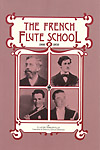The 'French Flute School'
The pupils of
Claude-Paul Taffanel at the Paris Conservatoire
had a strong influence on flute-playing in early-20th-century
Europe and America where many of them held prominent
orchestral and teaching positions and made some of the
first recordings of classical repertoire.
This so-called French Flute School used metal flutes
of the modified
Boehm system by Louis
Lot and others, and a playing style that featured
a light tone and vibrato. It stood in contrast to the
mostly wooden instruments German and English flutists
played with a strong and steady sound.
By the 1930s recordings had introduced the French sound
to people all over Europe and America. Euorpean flute-making
was in decline, while American makers, led by the William
S. Haynes Co. of Boston, were building copies of Louis
Lot-style Boehm flutes. When the English firm of
Rudall, Carte & Co. closed after World War 2,
the Lot-style metal flute became the only type in regular
production all over the world. At the same time the
school band movement gave almost all children the chance
to learn a wind instrument.
These are the main reasons why this French-influenced
instrument and playing style became the basis of a new
American-dominated International Style after c1970.
 Chapter 11, 'The French Flute School', of Ardal Powell's
The Flute (Yale University
Press, 2002) contains more information on this topic.
Chapter 11, 'The French Flute School', of Ardal Powell's
The Flute (Yale University
Press, 2002) contains more information on this topic.
 |
Claude Dorgeuille's The French Flute School,
1860-1950 is now permanently out of print.
|
 Other national styles
Other national styles
|